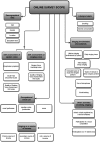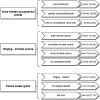Population characteristics and self-assessment of speaking and singing voice in Polish contemporary commercial music singers-an exploratory, cross-sectional study
- PMID: 38813421
- PMCID: PMC11133608
- DOI: 10.3389/fpubh.2024.1256152
Population characteristics and self-assessment of speaking and singing voice in Polish contemporary commercial music singers-an exploratory, cross-sectional study
Abstract
Background: The domination of the Contemporary Commercial Music (CCM) industry in music markets has led to a significant increase in the number of CCM performers. Performing in a wide variety of singing styles involves exposing CCM singers to specific risk factors potentially leading to voice problems. This, in turn, necessitates the consideration of this particular group of voice users in the Occupational Health framework. The aim of the present research was threefold. First, it sought to profile the group of Polish CCM singers. Second, it was designed to explore the prevalence of self-reported voice problems and voice quality in this population, in both speech and singing. Third, it aimed to explore the relationships between voice problems and lifetime singing involvement, occupational voice use, smoking, alcohol consumption, vocal training, and microphone use, as potential voice risk factors.
Materials and methods: The study was conducted in Poland from January 2020 to April 2023. An online survey included socio-demographic information, singing involvement characteristics, and singers' voice self-assessment. The prevalence of voice problems was assessed by the Polish versions of the Vocal Tract Discomfort Scale (VTDS) and the Singing Voice Handicap Index (SVHI). Also, a self-reported dysphonia symptoms protocol was applied. The perceived overall voice quality was assessed by a Visual Analogue Scale (VAS) of 100 mm.
Results: 412 singers, 310 women and 102 men, completed the survey. Nearly half of the studied population declared lifetime singing experience over 10 years with an average daily singing time of 1 or 2 h. 283 participants received vocal training. For 11.4% of respondents, singing was the primary income source, and 42% defined their career goals as voice-related. The median scores of the VTDS were 11.00 (0-44) and 12.00 (0-40) for the Frequency and Severity subscales, respectively. The median SVHI score of 33 (0-139) was significantly higher than the normative values determined in a systematic review and meta-analysis (2018). Strong positive correlations were observed between SVHI and both VTD subscales: Frequency (r = 0.632, p < 0.001) and Severity (r = 0.611, p < 0.001). The relationships between most of the other variables studied were weak or negligible.
Conclusion: The examined CCM singers exhibited substantial diversity with regard to musical genre preferences, aspirations pertaining to singing endeavors, career affiliations, and source of income. Singing voice assessment revealed a greater degree of voice problems in the examined cohort than so far reported in the literature, based on the SVH and VTDS.
Keywords: contemporary commercial music singers; demographic characteristics; professional voice; self-assessment; singing voice handicap index; vocal tract discomfort scale; voice disorders.
Copyright © 2024 Morawska, Pietruszewska, Politański and Niebudek-Bogusz.
Conflict of interest statement
The authors declare that the research was conducted in the absence of any commercial or financial relationships that could be construed as a potential conflict of interest.
Figures
Similar articles
-
Associations of Education and Training with Perceived Singing Voice Function Among Professional Singers.J Voice. 2021 May;35(3):500.e17-500.e24. doi: 10.1016/j.jvoice.2019.10.003. Epub 2019 Oct 31. J Voice. 2021. PMID: 31679926
-
Self-rated vocal complaints relationship to Vocal Tract Discomfort and Singers Voice Handicap Index in Iranian religious singers.Eur Arch Otorhinolaryngol. 2021 Jul;278(7):2411-2419. doi: 10.1007/s00405-021-06741-5. Epub 2021 Apr 10. Eur Arch Otorhinolaryngol. 2021. PMID: 33837834
-
Applicability of the Arabic version of Vocal Tract Discomfort Scale (VTDS) with student singers as professional voice users.Logoped Phoniatr Vocol. 2018 Jul;43(2):80-91. doi: 10.1080/14015439.2017.1363282. Epub 2017 Aug 18. Logoped Phoniatr Vocol. 2018. PMID: 28820002
-
Working 9-5: Causal Relationships Between Singers' "Day Jobs" and Their Performance Work, With Implications for Vocal Health.J Voice. 2017 Mar;31(2):243.e27-243.e34. doi: 10.1016/j.jvoice.2016.04.003. Epub 2016 Jun 25. J Voice. 2017. PMID: 27354167 Review.
-
Considerations and demands in the voice care of contemporary commercial singers in occupational health and safety aspects.Med Pr. 2022 Feb 18;73(1):33-41. doi: 10.13075/mp.5893.01201. Epub 2022 Feb 8. Med Pr. 2022. PMID: 35133326 Review.
References
-
- de Villiers AC, Gillmer R. An assessment framework for contemporary commercial music (CCM) in higher education. J Appl Res High Educ. (2023). doi: 10.1108/JARHE-11-2022-0337 - DOI
-
- Crawford E, Nielsen US. End of year music report 2017. (2017);1–33. Available at: https://strivesponsorship.com/2018/02/05/nielsen-us-year-end-music-repor...
-
- Edwards M, Hoch M. CCM versus music theater: a comparison. J Sing. (2018) 75:183–90.
MeSH terms
LinkOut - more resources
Full Text Sources
Medical
Miscellaneous




